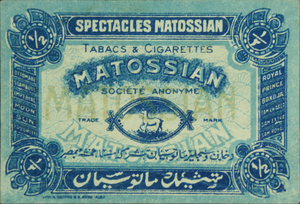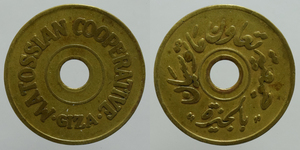Matossian
Description
Egypt's tobacco industry has a rich and diverse history, with Armenian families playing a significant role in its development. One of the most prominent of these families were the Matossian brothers, Armenian immigrants from Tokat, Turkey, who founded Egypt's largest tobacco factory. The Matossian Tobacco factories employed up to 70,000 workers and produced 90% of Egypt's cigarette production between 1895-1896.
The success of the Matossian brothers and their Armenian counterparts in the tobacco industry made them a significant and influential community in Egypt. However, in 1961, the nationalization program of President Gamal Abdel Nasser caused a decline in the Armenian community, most of whom were engaged in the private sector. Despite this, Joseph Matossian, then the chairman of Egypt’s Chamber of Tobacco, chose to adapt to the new landscape instead of leaving Egypt. He famously created Egypt's most-consumed cheap cigarette, The Cleopatra, in response to Nasser's request for a similar cigarette to the smuggled Kents he smoked.
The Matossian brothers were not the only foreign family to play a significant role in Egypt's tobacco industry. Greek industrialists such as Nestor Gianaclis and Ioannis Kyriazis also contributed to the development and expansion of the industry. Gianaclis established a factory in Cairo in 1871, which became the first major cigarette factory in Egypt. After the British troops began being stationed in Egypt in 1882, British officers developed a taste for the Egyptian cigarettes and they were soon being exported to the United Kingdom.
Despite the success of the tobacco industry in Egypt, tastes in Europe and the United States shifted away from Turkish tobacco and Egyptian cigarettes towards Virginia tobacco, during and after the First World War. What remained of the Greek-run tobacco industry in Egypt was nationalized after the Egyptian Revolution of 1952. Egyptian-made cigarettes were thereafter sold only domestically, and became known for their poor quality (and low price). Of all the many foreign imitations of Egyptian cigarettes, only Camel survived the remainder of the twentieth century.
In conclusion, the Matossian brothers and other foreign families played an integral role in the development of Egypt's tobacco industry. Their success brought prosperity to Egypt and made them significant and influential members of the community. While the decline of the industry and the nationalization program caused a decline in the Armenian and Greek communities, their legacy lives on in the products they created and the impact they had on Egypt's economy and society.
During the early 20th century, the Matossian Tobacco Company in Egypt produced paper tokens that were utilized as a form of currency for small denominations. Due to the lack of small coins caused by the economic situation in Egypt at that time, these tokens served as a substitute for small change. While paper tokens were used in other countries as well, they were especially prevalent in Egypt during this period, where they were employed for various transactions like transportation systems and vending machines. Many companies, including the Matossian Tobacco Company, produced paper tokens of varying denominations.
The success of the Matossian brothers and their Armenian counterparts in the tobacco industry made them a significant and influential community in Egypt. However, in 1961, the nationalization program of President Gamal Abdel Nasser caused a decline in the Armenian community, most of whom were engaged in the private sector. Despite this, Joseph Matossian, then the chairman of Egypt’s Chamber of Tobacco, chose to adapt to the new landscape instead of leaving Egypt. He famously created Egypt's most-consumed cheap cigarette, The Cleopatra, in response to Nasser's request for a similar cigarette to the smuggled Kents he smoked.
The Matossian brothers were not the only foreign family to play a significant role in Egypt's tobacco industry. Greek industrialists such as Nestor Gianaclis and Ioannis Kyriazis also contributed to the development and expansion of the industry. Gianaclis established a factory in Cairo in 1871, which became the first major cigarette factory in Egypt. After the British troops began being stationed in Egypt in 1882, British officers developed a taste for the Egyptian cigarettes and they were soon being exported to the United Kingdom.
Despite the success of the tobacco industry in Egypt, tastes in Europe and the United States shifted away from Turkish tobacco and Egyptian cigarettes towards Virginia tobacco, during and after the First World War. What remained of the Greek-run tobacco industry in Egypt was nationalized after the Egyptian Revolution of 1952. Egyptian-made cigarettes were thereafter sold only domestically, and became known for their poor quality (and low price). Of all the many foreign imitations of Egyptian cigarettes, only Camel survived the remainder of the twentieth century.
In conclusion, the Matossian brothers and other foreign families played an integral role in the development of Egypt's tobacco industry. Their success brought prosperity to Egypt and made them significant and influential members of the community. While the decline of the industry and the nationalization program caused a decline in the Armenian and Greek communities, their legacy lives on in the products they created and the impact they had on Egypt's economy and society.
During the early 20th century, the Matossian Tobacco Company in Egypt produced paper tokens that were utilized as a form of currency for small denominations. Due to the lack of small coins caused by the economic situation in Egypt at that time, these tokens served as a substitute for small change. While paper tokens were used in other countries as well, they were especially prevalent in Egypt during this period, where they were employed for various transactions like transportation systems and vending machines. Many companies, including the Matossian Tobacco Company, produced paper tokens of varying denominations.



